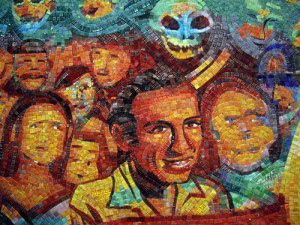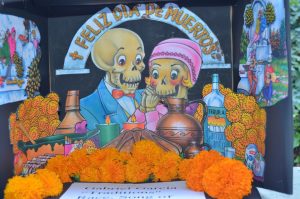Nicolas Gomez- Chicano/a Art
 “Chicana Mural” inspired by Diego Rivera is licensed under CC BY-NC 3.0
“Chicana Mural” inspired by Diego Rivera is licensed under CC BY-NC 3.0
 “Chicano Legacy” mosaic by Maria Torero is licensed under CC BY-SA 3.0
“Chicano Legacy” mosaic by Maria Torero is licensed under CC BY-SA 3.0

“Traditions” by Gabriel Garcia is licensed under CC BY-SA 3.0
Preface: Hi, my name is Nicolas Gomez and my portfolio is on Chicano/a art and the importance it had in the Chicano Movement. The licensing I will be using is CC BY-SA.
Introduction: This portfolio will cover the importance that Chicano/a art had on the Chicano movement. Mexican American artists established a unique artistic identity in the United States, much of the art and the artists creating Chicano/a Art were heavily influenced by the Chicano Movement which began in the 1960s. The movement was a socio-political movement by Mexican Americans coming together to create a unified voice to enact change for their people. The Chicano Movement was focused on a fight for civil and political rights of its people. Chicanos have used art to express their cultural values, as protest or for artistic value, the artwork speaks to them because it demonstrates their culture and history.
Themes: The two themes that my portfolio will be addressing is the cultural importance in all of the artwork produced by these Chicano/a artists and the variety of messages that each piece of artwork depicts. The Chicano/a artists heavily involve many different aspects of Mexican culture, that all have a significant importance in their lives. They demonstrate the hardships that their people have had to go through in life, they create art that allows them to remember the people who were instrumental in getting them where they are today, there are also artists that use their pieces of work to protest. Culture is so important in Chicano/a art, because the artwork is able to tell a story about the lives of Mexican American people and all they have had to go through.
Analysis: The Chicano/a art movement began roughly after the rise of the Chicano movement, the art was influenced by post-Mexican Revolution ideologies, pre-Columbian art, European painting techniques and Mexican-American social, political and cultural issues. Some aspects that the artwork focused on were the history and culture, restoration of land grants, and equal opportunity for social mobility for all Mexican Americans. The first piece of artwork that I included in my portfolio, is a mural located in Balmy alley, which is a very popular alley that contains a collection of murals, it is located in San Francisco, California. Murals created by Chicano artists reclaim public spaces, encourage community participation, and aid in neighborhood development and beautification. Chicano/a art has drawn much influence from prominent muralists from the Mexican Renaissance, such as Diego Rivera and José Orozco and in the case of the first piece of artwork that I included, the artist or artists were inspired by Diego Rivera to create this masterpiece. The second piece of artwork that I included in my portfolio is a mosaic done by Maria Torero, it is a mural of Carlos Blanco Aguinaga located on the University of California, San Diego campus, he was a very distinguished literary critic and fiction writer, who was a founding member of the University of California San Diego Department of Literature. He was the faculty advisor for the Mexican American Youth Association. His experience of exile, political commitment, literary sensibility, and generosity as a mentor to the youth, contributed to make Carlos Blanco Aguinaga an especially influential intellectual, scholar of Spanish and Latin America literature and a very helpful person. The third and final piece of artwork that I included is a depiction of an event that is celebrated every year in Mexican American culture, known as Dia de los muertos, or Day of the Dead. As new generations arise, Chicano/a art plays a role in educating their youth about essential histories, traditions and values of their identity and culture. One of the most celebrated holidays in Mexican culture is the Day of the Dead. The holiday focuses on gatherings of family and friends to pray for and remember family and friends who have died. So it goes to show you that there are so many pieces of Chicano/a artwork that contain a specific message that it addresses.
Application: Chicano/a art was influenced by the Chicano movement, but even after the movement dissolved, Chicano art continued as an activist endeavor, challenging the social constructs of discrimination, citizenship and nationality, and labor exploitation, in an effort to create social change. Chicano art in its activist endeavors has become a form of popular education, of the people and by the people, in its ability to create a serious discussion about these issues while also empowering Chicanos to construct their own solutions. I believe that Chicano/a Art is very important in understanding the effects that injustice can have on a group of people. Chicano/a Art reveals the true reality of everything a Chicano might go through in their lifetime. Racism, discrimination, injustice, all those things can negatively affect a person on the inside. Which is why the Chicano movement came to action, they were looking for a way to improve their quality of life, and through the use of art and many other things, they were able to improve it.

